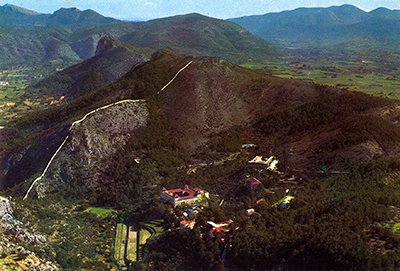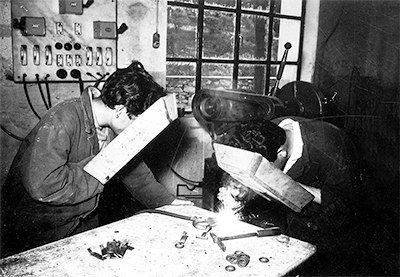Presentation of the Fontilles and leprosy in Spain portal
By Antonio García Belmar (University of Alicante)

In January 1909, eight men affected by leprosy were driven from several villages in the Marina Alta region of Alicante to a nearby valley formed by the Fontilles and del Moro ravines at the mouth of La Vall de Laguar valley. The location had many water sources, it was protected from northerly winds by the mountains, it was sunny, well ventilated and it offered a perfect visual asymmetry: one could contemplate the sea from any point in the valley without being seen from any inhabited surrounding location. The eight men were housed in the Virgen de los Desamparados pavilion, one of the four buildings that had been built two years earlier by workers from the neighbouring villages thanks to the financial support of a group of Valencian philanthropists led by the lawyer Joaquín Ballester and the Jesuit Carlos Ferris.

Throughout the twentieth century and to the present day, successive constructions in this spot, an area that is physically and symbolically isolated from the rest of society, eventually housed two thousand six hundred and twenty-one people affected by leprosy. They lived - many, for the rest of their lives, and others, for many years - in the care and custody of Franciscan sisters and Jesuits, dozens of volunteers, a small medical team and workers, depending on the charitable donations of hundreds of people, groups and entities and diverse governmental subsidies. The Fontilles Valley buildings, walls, fields and landscape bear witness to these lives, to the personal and collective histories they defined and also to the yet unknown aspects of Spain's social, political, medical and cultural history. Thousands of documents, books and journals, photographs and posters, tools and instruments have been carefully preserved in the sanatorium's facilities to keep records of the work, leisure, worshipping, care, treatments, research, artistic expression and experiences of those who lived there.
The Fontilles and leprosy in Spain portal seeks to shed light on that closed world. The website results from a collaboration between the Fontilles Foundation and the University of Alicante. It is indebted to the Sasakawa Health Foundation, which provided the necessary funds to recover, digitize and edit the wide-ranging series of documents, works, images and objects of Fontilles' historical heritage. These materials are now available to anyone interested in them and, above all, to those who, thanks to them, may be interested in the history of Fontilles and leprosy in Spain.

The bibliographic catalogue provides a sample of the works preserved in the Fontilles Medical Library. All the works have either been written by authors with links to the sanatorium, or they are related to Spain's history of leprosy. A range of literary and historical works, already present in the general catalogue of the Library Biblioteca Virtual Miguel de Cervantes, were also selected according to the same criteria. The Journal catalogue includes the two journals published by the sanatorium: the Revista de Leprología, a major research dissemination channel on leprosy ever since it appeared in 1944, especially in the Spanish-speaking world; and the Fontilles magazine, published since 1905 - initially called La Lepra - to disseminate the sanatorium's activities and to help fundraising. The digital edition of the Fontilles journal offered here is the only complete collection of the journal available. It was reconstituted thanks to the collaboration of the Biblioteca Virtual de la Prensa Histórica, where it can also be consulted.

The Image bank contains a small sample of the thousands of photographs preserved in the Fontilles Photo Archive. They were selected according to their technical and artistic quality, the information they provide or because they were particularly representative compared to similar images. Care was continually taken to protect the identity of the people admitted to the sanatorium. To make them easier to search through, the images have been classified according to the three axes around which the sanatorium's site and the lives of its residents were organised. These three axes were: the separation between men and women; between «healthy» and «sick» people; and between the inside and outside world. The panoramic views and details of the main infrastructures create an initial understanding of how the sanatorium evolved, from the moment it was conceived and driven by its promoters, at the beginning of the twentieth century, until its definite configuration in the 1950s. The images show the places of residence, medical care, work and leisure of the nine hundred and sixty three women and the places of residence, medical care, work and leisure of the one thousand six hundred and fifty-eight men who lived in the sanatorium. A separate gallery illustrates the boarding school where the sons and daughters of the men and women interned in the sanatorium lived and studied. A series of galleries also show the places of residence and work of the so-called «healthy staff»: the Franciscan sisters who, ever since their arrival in 1909, took physically care of patients; volunteers who helped in these tasks; the Jesuits, who took spiritually care of the whole community and managed the sanatorium, and the workers who lived with their families in the sanatorium and were responsible for its maintenance. Image galleries of the medical staff show medical treatments and research undertaken as well as the activities and people in charge of clinical assistance and laboratory research. The meeting places, aimed at bringing together the entire Fontilles community, help us to understand the difficulties in achieving a balance between respecting segregation rules between men and women and between «sick» and «healthy» people, and the need to share moments of celebration, commemorations, or simply enjoyment. The church, the theatre or the central sanatorium square well illustrate these places of shared worship, leisure and commemoration, including moments of parting, on the way to the cemetery. The wall marks the boundaries between the intramural and outward-looking Fontilles, that depended on the outside world to survive. The guesthouse welcomed and housed visitors who considered Fontilles as an inspiration for their spiritual exercises and a good cause to which to make material contributions. For those visiting their relatives, the visitors pavilion served as a makeshift meeting place.

Leprosy has been described, narrated and studied by writers, researchers and historians. They have sought to explain the origin of the disease, how it spread, and its consequences. Maps and graphs have also been produced to describe the different forms of the disease, its geographical distribution or epidemiological evolution. Some of them have been extracted from the books included in the catalogue and published in an image gallery which also includes a selection of the sanatorium's architectural plans and projects still preserved in the Fontilles Archive.
The project to recover and disseminate Fontilles' historical heritage is ongoing. In addition to what has been accomplished so far regarding the bibliographic and iconographic archives presented here, three key components of Fontilles' historical heritage will be addressed in the coming years. First, a rich archive containing all the documentation generated by the institution's administrative management and the clinical records relating to medical and research work. Second, its material heritage, that includes a highly diversified range of objects including clinical and laboratory instruments as well as tools and machines used in the craft and training workshops. A brief review of these artefacts are included in the archive section, pending samples of all these materials. The third component is the voice of the people who inhabited Fontilles. The audio library will collect the oral testimony of people who wished, and were able, to tell about a life revolving around leprosy.
Finally, the Fontilles and leprosy portal in Spain offers a small bibliography, which includes Spain’s major historical and epidemiological leprosy studies, and a selection of links to leprosy resources of great interest on the history and current situation of leprosy in the world.